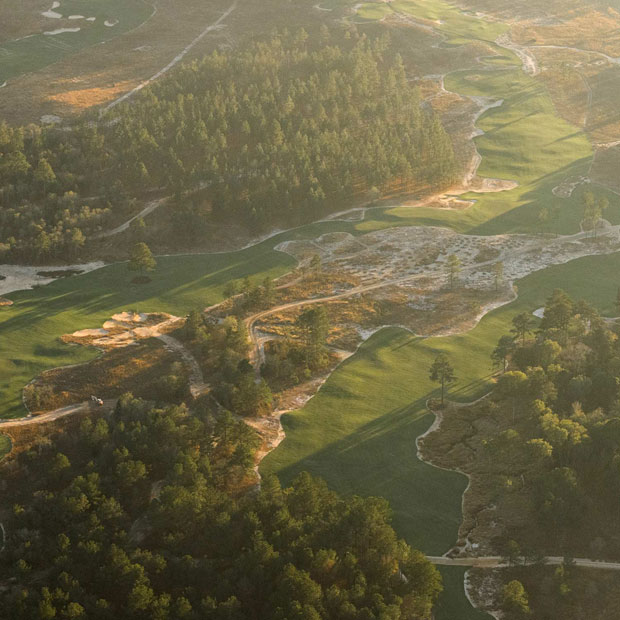A Taste of Scotland in Nova Scotia: Cabot Links
A visit to the Rod Whitman designed Cabot Links in Inverness, Nova Scotia


Every travel-minded golfer in the Eastern Time Zone has Cabot Links Resort pinned to the top of their bucket list. The closest thing that North America has to the old sod of golf’s birthplace, Cabot occupies the site of a former coal mine along the shores of Cape Breton Island. Every hole on this 2011 Rod Whitman design boasts water views, either of the Gulf of St. Lawrence or MacIsaac’s Pond, the tidal inlet that shelters a picturesque working harbor beyond the sixth green.

From the first hole it’s clear Whitman was blessed with two distinct advantages on this project before he even picked up a pencil. The first was a plot of land akin to those of some of the greatest links courses in Great Britain and Ireland – a strip of sand-based turf that runs from the water up towards the small town of Inverness, Nova Scotia, and contains enough humps, hillocks, and hollows to make a hobbit feel at home. The site is roughly rectangular, with a long edge running along the coast that offers enough land for a variety of stunning seaside golf holes. And the second was the financial backing of Mike Keiser, the patron saint of modern golf construction.
Cape Breton Island was already on the world golf radar thanks to Highlands Links, a Stanley Thompson masterpiece in the top northeast corner of the island that seamlessly blends mountains and ocean into one of the most diverse collections of 18 holes in North America. But with the addition of Cabot Links in 2011 and its sister course, Cabot Cliffs, in 2016, one of Canada’s outermost regions is getting its time in the spotlight.

Course map by Riley Johns of Integrative Golf
There are no weak holes at Cabot Links. The land might not be quite as dramatic as the Cliffs course, but Whitman made great use of it, giving players a variety of distances, directions and feels. What follows are a handful of the highlights that players can expect when they make the trek to Inverness.
Many thanks to Photographer Evan Schiller (@evan_schiller) for contributing his beautiful photos and to Riley Johns of Integrative Golf (@integrativegolf) for his course art.
HOLE #6 – 465/440 yards – par 4
This hole was absolutely stunning. Even after playing the Cliffs, which supplied me with probably 4 of my favorite 5 golf holes of all time, this might still be the one hole I’d return to play over and over. The clearance over the bay is just short enough to be enticing, but long enough that nothing short of a great tee ball will do it. Alternatively, you can play up the right and leave yourself a short iron (or a bouncing long iron) into a green that slopes from back to front and is tilted, as the entire hole is, towards the pond. It’s a gorgeous hole.

HOLE #7 – 192/186 yards – par 3
The third par-3 on the front nine is the dunesiest hole on the course – it feels like you’re playing in the British Isles with the water behind, the long-grassed dunes, and the deep pot bunkers hiding beside this green. It’s also the one hole where the way forward isn’t apparent right from the tee box, which is actually a refreshing change. Most of the holes at Cabot present your challenge head-on: hit this fairway, then attack this quadrant of the green. The 7th green sits in a depression amongst the dunes, but it’s not readily apparent as you stand on the tee. After you pick out the fluttering flag, you’re tasked with placing your tee shot over the shaggy hillocks and down into the correct depression in the seaside landscape. It’s honestly the closest I’ve ever felt to just dropping a ball while wandering around near the ocean and hitting it.
{{content-block-cabot-links-001}}
HOLE #8 – 580/550 yards – par 5
Eight is a classic Cabot hole in that it has a ton of landing space in the driving area, but it takes a well-placed drive to give yourself a look at birdie or possibly eagle. It’s a par-5 with a blind second, a trait that this hole shares with the uber-long 11th. The closer you stay to the left side of the fairway, the shorter (and clearer) path to the massive double green you’ll have. And when I say massive, I mean MASSIVE. The 8th and 13th greens at the Links are connected, and both are framed by what came to feel like the crossroads of the course — a large mound that is home to the 9th, 12th, and 14th tees.

HOLE #11 – 620/580 yards – par 5
This hole’s proportions are mythical in their enormity. The 11th was the hole that best prepared me for the monstrous scale of Cabot Cliffs. At 580 yards from our tees, it was easily the longest par-5 I’ve ever played. The tee shot plays to a fairway sloping left to right, and longer hitters can reach a speed slot that returns a few precious extra yards. From there, it’s anybody’s guess how you’ll reach this green.
Do you opt to lay up onto the peninsula of fairway jutting towards the ocean about 100 yards back from the green? Or do you stay up the left side, flirt with that hilltop bunker, and give yourself a wedge shot with the entire green open to you? The green is benched into a mound, with a sloped area left that helps to feed long second shots along the ground towards back hole locations.

HOLE #13 – 440/420 yards – par 4
The 13th is the third par-4 in four holes, and the second one with a blind tee shot. This is probably the toughest and most confusing tee shot on the course, as the fairway is completely blocked by a bunker-riddled hillside. It’s one of the few times when hiring a caddie is a real advantage, as it is a “hit it and hope” proposition on the first go-round. The more right off the tee, the better, as this hole plays up to the other side of the giant double green that’s shared with the 8th. The left hand side is peppered with mounds of fescue and a greenside bunker, while the right allows running right-to-left shots to find the large, undulating putting surface.

HOLE #14 – 102/95 yards – par 3
There’s not much to say about this beauty. Too short, and you’re in the bunker. Too long, and you’re in the ocean. The card reads 95 yards, but depending on wind, it can play anywhere from 50 to 150. Pick your club, trust your swing, and let it fly. An interesting architecture note – when the Links course first opened in 2011, the front and left bunkers were nowhere to be found. They were an addition that frame the hole nicely while keeping the infinity green intact.

HOLE #15 – 413/385 yards – par 4
This short-ish par-4 hugs the coastline and elicits memories of the tee shot at the 8th. The closer you stay to the left hand side of the fairway, the better angle you have into the green. The fairway does slope towards the ocean, which helps balls feed down into better playing positions. Though smaller, this green definitely had personality. It’s an inverted L shape with its long side facing directly at the fairway, and the leg of the L jutting off at the back right. In the armpit of the green is one of the most treacherous bunkers on the course, which dictates strategy on every shot until you’re inside 10 feet.

HOLE #16 – 457/430 yards – par 4
This is the ideal links golf hole. Oceanside from beginning to end, central hazards, a rumpled fairway, rewards for pulling off the risky play, an open green front, and an abundance of options on both tee and approach shot for golfers of all skill levels. Similar to the 6th and 13th, the green rewards approaches sent running onto the putting surface from right to left. After putting out on the 16th, you’d be remiss to not take a moment to look back along the coast and get a bit wistful at the stretch of seaside golf holes you’ve just completed. The double-green 13th, drop-shot infinity green 14th, seesaw 15th and strategic 16th compose a world-class four-hole stretch.

The focus of this profile was obviously the seaside holes, as they are the main reason to seek out a golf experience like the one provided at Cabot. To be clear though, the inland holes at Cabot Links provide as much interest, challenge and fun as their more photogenic course-mates. It is the type of course that just makes you want to go around and around and around in a joyous attempt to unlock all of its secrets.
Leave a comment or start a discussion
Engage in our content with thousands of other Fried Egg Golf Club Members
Engage in our content with thousands of other Fried Egg Golf Members
Get full access to exclusive benefits from Fried Egg Golf
- Member-only content
- Community discussions forums
- Member-only experiences and early access to events










Leave a comment or start a discussion
Lorem ipsum dolor sit amet, consectetur adipiscing elit. Suspendisse varius enim in eros elementum tristique. Duis cursus, mi quis viverra ornare, eros dolor interdum nulla, ut commodo diam libero vitae erat. Aenean faucibus nibh et justo cursus id rutrum lorem imperdiet. Nunc ut sem vitae risus tristique posuere. uis cursus, mi quis viverra ornare, eros dolor interdum nulla, ut commodo diam libero vitae erat. Aenean faucibus nibh et justo cursus id rutrum lorem imperdiet. Nunc ut sem vitae risus tristique posuere.